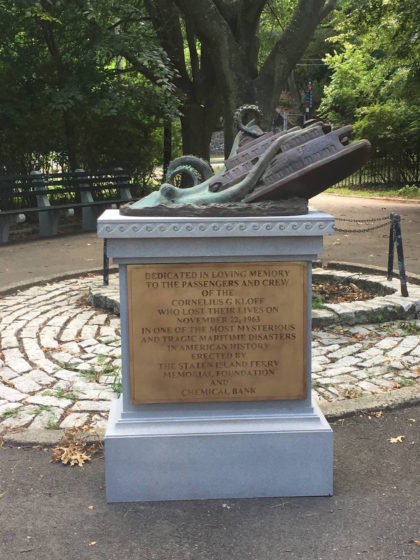In the News: Legislation to Limit Tour Buses
••• David W. Dunlap writes about the “resurrection of Greenwich Street” in the New York Times. He sees more progress than I do in regard to the weaving of Greenwich back into the fabric of the city. But this was of note: “Greenwich Street is also where the last unresolved battle over the future of the World Trade Center is being fought. The city and the Lower Manhattan Development Corporation favor the construction of housing on a parcel known as Site 5, where the Deutsche Bank building stood. The Port Authority of New York and New Jersey believes the site should to be used for offices, a conference center and a hotel.”
••• Tribecan Michele Cardella writes about the loss of the Food Emporium, her aversion to Whole Foods, and the opening of Best Market. —Habitat
••• Press release: “Today at 1 p.m., a bill introduced by Council Member Margaret Chin to limit the number of tour buses on City streets will be heard at a joint hearing of the Council’s Consumer Affairs and Transportation committees. The bill, Intro 950, would limit the number of active license plates that the city Dept. of Consumer Affairs can issue to sightseeing buses. […] In 2014, 56.5 million visitors came to New York City to visit, shop, and eat, an increase of more than 16 million people in just 10 short years. Similarly, the number of sightseeing tour buses have tripled between 2003 and 2014. This sensible limit will accommodate our city’s vital tourism industry while addressing the concerns of residents.” Someone should play the health card: Walking is always better than being driven around, as the city is always hectoring us.
••• “It’s the city’s secret tragedy: the giant-octopus attack on the Cornelius G. Kolff, a Staten Island Ferry boat dragged to a watery grave with 400 souls aboard on Nov. 22, 1963. […] Artist Joe Reginella [is a] hoaxster whose slick brochures, website and even a statue are luring hapless tourists to a far corner of Staten Island in search of a museum devoted to the fantastical fish tale. […] He carts his “’memorial’ statue depicting the tragic event in cast bronze to Battery Park and other public locations and watches the startled reactions of passers-by.” —New York Post















I went to that tour bus meeting and spoke, pointing out that in historic centers of European cities that have street patterns like lower Manhattan, tour buses are not permitted, and these cities are doing fine, so it seems most tourists can walk if they have to. I’m not sure they’re on the right track with some of what they’re trying to do, because what is needed is enforcement and the police are already busy etc. etc. so it will look good on paper but not on the street. Plus the Bronx and Brooklyn are actually hoping for more tour bus action.
Was there any data provided at the meeting for 2015 or year-to-date 2016? I’m a relative newcomer to this part of downtown and even in the 2.5 years that I’ve lived here, I’ve noticed a seemingly large increase in the tour bus traffic in and around City Hall Park and then obviously the WTC vicinity.
There was a lot of data but I zone out on numbers so this is what I got. The number of tour buses tripled from 2003-13. There are currently 237 buses operating, and the legislation would limit them to 225, so big whoop there. At one time there were many more bus companies but fewer buses; now there are only 5 companies. Some speakers were concerned about this and thought it should be easier for more companies to enter the market, but I think it’s the same as everything else–big companies driving out smaller ones.
Other trivia: *The people from the Bronx and Brooklyn who spoke are afraid that limiting the number will mean fewer buses going there, and they actually WANT more. *Someone from the DT Alliance counted 74 buses below City Hall in a short amount of time one day (sorry, not sure how many hours that was). *The Department of Consumer Affairs and CB2 speakers wanted to raise fines for traffic and parking violations and revoke licenses for having too many. *Another topic that came up were the “rolling buses”–the ones with the big ads and sometimes fancy lighting; when they’re empty they just drive around anyway so they can display the ads. *There were two different figures given for tour bus licenses: either $25 or $100 every two years per bus–the first figure may have been for an initial fee and the second for the license plate for the buses but the first wasn’t clear. At any rate, way too cheap. And a mere $115 per parking infraction. *Somebody read the legislation on the books re tour buses and it is so old that it includes horse-drawn vehicles. I don’t get why they’re not doing a complete re-do.
Thanks for this. Tourist buses are annoying, no doubt, but on Broadway and Church the bigger disturbance is from commuter buses making their way up and down through Lower Manhattan every weekday morning and night. The buses are older—noisier and worse for our air quality—than MTA buses. My guess would be that the Downtown Alliance’s count included a lot of commuter buses.
I just got Margaret Chin’s newsletter and here’s the paragraph about the tour buses, with slightly different numbers. I am sure that there were several contradictions about numbers at the meeting or it could have been that I was sitting in the back behind a post and misheard.
—
According to the state Dept. of Transportation (NYSDOT), the number of double-decker sightseeing buses in the city more than tripled from 57 to 194 between 2003 and 2013. Today, there are approximately eight NYC sightseeing bus companies that operate a fleet of 229 – with nine plates currently pending. The number of active, registered sightseeing buses was as high as 299 in September 2014.
—
So the legislation would remove even fewer buses from the street than I said originally. I just don’t see capping the number to be the solution; if there’s 225, 224 of them will still want to go downtown. The solution has to be prohibiting buses in certain areas plus a whole slew of other disincentives.